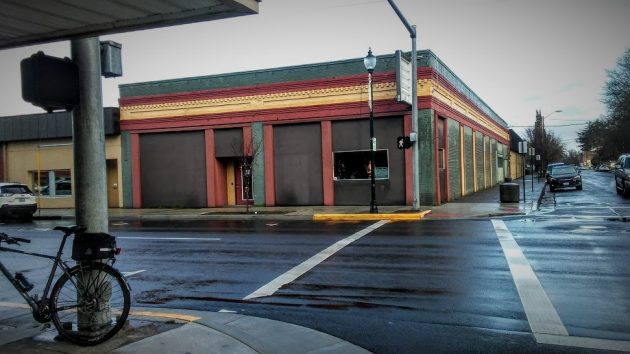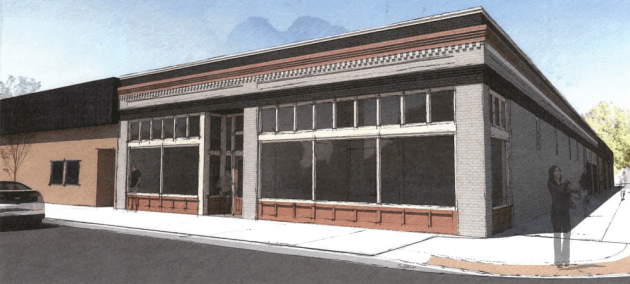
The northeast corner of Third and Lyon in downtown Albany looked like this today. By next summer, if everything goes according to plan, it will look more like this:

The former Pizza King building at the corner doesn’t look like it but it’s a historic landmark downtown. And its new owner, the C.H.A.N.C.E. organization, plans to restore the outside to look more or less the way it did when it housed the King Griff store and offices a century ago.
As you know by now, C.H.A.N.C.E. is a regional nonprofit that runs programs to help people overcome their addictions. (It stands for “Communities Helping Addicts Negotiate Change Effectively,” and if they dropped the all-upper case letters separated by periods the name would be easier to type.)
Last week I reported that after the first of the year Chance (let’s just call it that) will take over the 140-bed Signs of Victory homeless shelter at Jackson and 11th and run as it the “Second Chance Shelter.”
This week, the news is about the former pizza restaurant at Third and Lyon, which Chance bought, remodeled over the last year or so, and moved into on Dec. 4.
On Wednesday, the city council, acting as the Albany Revitalization Agency, approved a $75,000 forgivable loan to Chance. This will allow the organization to restore the exterior. (Varitone Architecture of Albany provided the plan for the restoration. The rendering above was done by the firm.)
The loan from the city’s CARA urban renewal program, at 3.25 percent annual interest, will be forgiven if the applicant completes the exterior restoration by June 30, 2021.
The CARA advisory board originally approved $150,000 in financing aid for the project, half as a term loan and the other half forgivable. Chance decided it would seek only the forgivable half. There was no debate Wednesday, and the council approved the request without dissent.
Looking forward to seeing those big old windows facing Lyon Street when the restoration is done. (hh)

CARA uses Tax Increment Financing. In other words, there is an expectation that CARA’s “investment” will be more than offset by the expected increase in future property taxes.
How much was the most recent property tax on this property before the CHANCE purchase?
How much annual property tax is projected to be paid after the CHANCE project is complete?
How long until this “investment” of $75,000 is paid back?
1 year? 5 years? Infinity?
You are correct Gordon,
I believe they have volunteered to pay for their county/city services for a limited time, but they are under no obligation to pay anything for the services they use.
There will be no return on taxpayer money used to increase the value of the property, no ancillary increase in overall value of the downtown as an an upgrade in infrastructure would produce. If they abide by the agreement, they are not required to pay back the loan, there will be no TIF collected, it is yet another piece of the downtown that going forward will not be paying for services and will be taken off the tax roles. This falls far outside the intention of CARA, does anyone ask on the CARA board how does this benefit downtown and the community as a whole?
Just to be clear: The former pizza restaurant has remained on the tax rolls since Chance bought it in 2018, and property taxes have continued to be paid. The tax bill was $4,370 in 2018, $4,486 in 2019, and $4,594 in 2020.
Did the approved ARA Resolution contain this clause?
“Return of Public Funds: The return of the public funds through tax-increment increase is not anticipated in the foreseeable future while under C.H.A.N.C.E.’s ownership.”
CARA justifies itself financially by claiming a positive return on its “investments.” But it appears the return on this transaction is zero. This makes the payback period infinity.
If the above is accurate, doesn’t this “investment” violate a public trust given CARA uses tax-increment financing (TIF)?
I commend them for realizing that not everyone can be exempt from paying for services. The quote from Mr. Blackford…. “As a nonprofit we can apply for a tax exemption,” he said. “But we decided we would defer that for five years and contribute to the city of Albany.” Obviously this is completely voluntary as to whether they pay for services or not, they can stop next year.
https://www.gazettetimes.com/news/local/chance-to-move-downtown-expand-services/article_a961f515-5651-59bb-85b1-e6a0158c8ad9.html
My biggest concern is how much of the downtown is going to be converted to non-performing assets or long term moratoriums on TIF increases. We’re running out of those that are paying the bills.
Reframing from comment re: the ROI on taxpayer monies, I see this as an investment in human beings by making the building nicer & creating a better atmosphere for the people being helped by CHANCE as well as others in the neighborhood. In most developed nations addiction would be considered a public health issue & public budgets would reflect that viewpoint. CHANCE has developed from a tiny effort in a store front on 3rd where it began with very little other than a few people dedicating themselves to helping people addicted to drugs (including ethyl alcohol) to where they are today. We invest in benches that face buildings AND the street without rhyme or reason, so why not in restoring an old building to its former glory & making it an inspiration to our community of what we can do to help our people?
You ignore that CARA uses tax-increment financing, i.e., the $75,000 is ultimately paid back from the increased property taxes that result from the re-development.
On this project, the city council goes into it KNOWING the $75,000 will never be returned. This is a violation of trust with the people who front the money – property taxpayers.
And if you want the city to “invest” in human beings, fine. Just do it through other means. TIF is intended to fix blighted urban areas, not blighted human behavior.
No one is arguing that CHANCE is not engaging in a noble cause.
We have many organizations that we pay massive amounts of public capital into for “investment in human beings”, GAPS being the largest, Linn/Benton Community College another.
You’re asking for something that CARA is not designed for or marketed to the community as. Blight is only one aspect of CARA but the other is the expectation that taxpayer dollars will increase taxable assessed values in the district in order to pay back borrowed funds. If you’re advocating for a taxpayer funded charity or public funded addiction treatment center that’s an entirely different discussion. After seeing the complete destruction that Corvallis is going through right now, that discussion may need to be brought to the forefront. I would like to see Mayor Konopa lead a task force on this issue since she is the expert in dealing with this.
Notwithstanding the naysayers, the URD has definitely improved things in its defined area. And once the Waterfront project is completed, we’ll button it up and Albany will be the better for having started the URD & finishing it.
I simply don’t see enough “historical difference” from the old & newer designs to even bother spending the money.
Then it hit me…
The reason all you naysayers rail against the URD district. It’s …gasp…SOCIALISM.
As you sip on your social retirement & social medical care.
Period.
Absurd- The ones you refer to are the ones that ACTUALLY WORKED for a living and had money extracted from their wages.